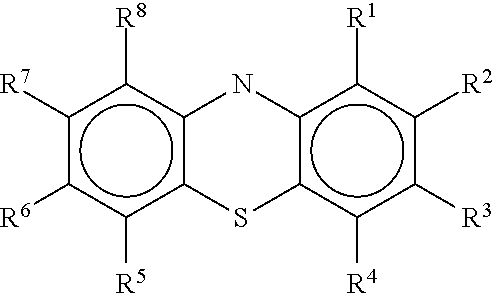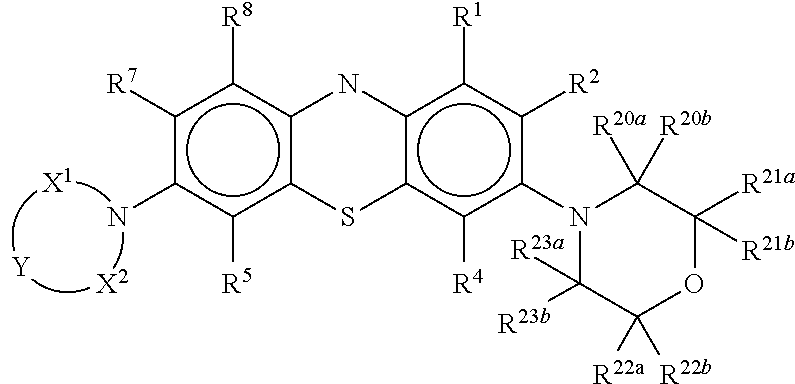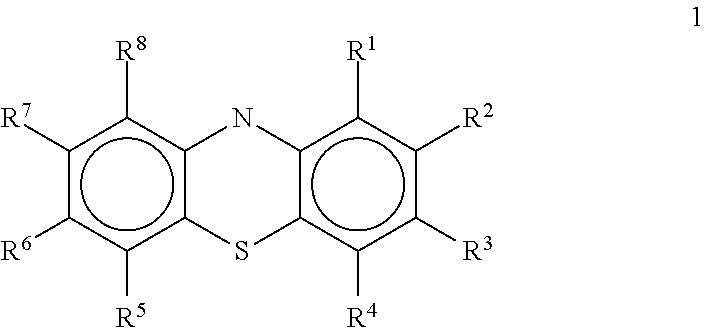Antiviral Compounds
a technology of antiviral compounds and compounds, applied in the field of compounds for preventing and treating viral infections, can solve the problems of affecting the effect of antiviral treatment, affecting the safety of patients, and causing toxic effects for a long tim
- Summary
- Abstract
- Description
- Claims
- Application Information
AI Technical Summary
Benefits of technology
Problems solved by technology
Method used
Image
Examples
example 1
1-Fluoro-10H-phenothiazine
a. Synthesis of N-Acetyl-2-fluoroaniline
[0196]Acetic anhydride (57 mL, 0.6 mol) was added slowly, over approximately 40 min., to stirred 2-fluoroaniline (55.7 g, 0.5 mol) under cooling (water bath) to maintain the reaction temperature at 60-70° C. After 10 more hours the reaction mixture was poured into H2O, the whole was extracted with ethyl acetate (2×300 mL). The combined organic extracts were washed with 5% aqueous NaHCO3, brine, dried (K2CO3), filtered and concentrated to provide the title compound as a white solid (67.0 g, 88%).
b. Synthesis of N-Acetyl-2-fluorodiphenylamine
[0197]A mixture of the N-acetyl-2-fluoroaniline (61.2 g, 0.4 mol), anhydrous K2CO3 (55.2 g, 0.4 mol), CuI (38.0 g, 0.2 mol) and bromobenzene (234 mL, 1.0 mol) was stirred and heated at 175-180° C. under an Argon atmosphere for 72 h. After cooling the reaction mixture was poured into ice-H2O and extracted with ethyl acetate (2×200 mL), the combined organic extracts were washed with b...
example 2
Synthesis of 3,7-Bis-morpholino-1-fluorophenothiazin-5-ium chloride
a. Synthesis of 3,7-Dibromo-1-fluoro-10H-phenothiazine
[0200]1-Fluoro-10H-phenothiazine (1.34 g, 6.2 mmol) was dissolved in acetic acid (10 mL) and stirred at room temperature as a solution of bromine (2.96 g, 0.95 mL, 18.5 mmol) in acetic acid (50 mL) was added. The mixture was allowed to stir overnight at this condition. To this mixture sodium sulfite Na2SO3 (1.56 g, 12.4 mmol) and water (2 mL) were added. The mixture was stirred at room temperature for 3 h. After that reaction mixture was poured into 100 mL of ice-water contained NaOH (1.0 g, 25 mmol). The mixture was stirred overnight and filtered, gave light green solid (1.70 g, 73%).
b. Synthesis of 3,7-Dibromo-1-fluoro-10-Boc-phenothiazine
[0201]3,7-Dibromo-1-fluoro-10H-phenothiazine (1.7 g, 4.5 mmol) was suspended in CH3CN (20 mL) and (Boc)2O (2.94 g, 13.5 mmol) and DMAP (0.55 g, 4.5 mmol) were added. The mixture was warmed to 50 C. After 5 min. starting materia...
example 3
Synthesis of 3-Morpholino-7-(pyrrolidin-1-yl)-1-fluorophenothiazin-5-ium chloride
a. Synthesis of 3-Morpholino-1-fluoro-7-bromo-10-Boc-phenothiazine
[0204]To a stirred solution of 3,7-dibromo-1-fluoro-10-Boc-phenothiazine (8) (290 mg, 0.6 mmol) in toluene (10 mL) Pd(dba)2 (17.3 mg, 0.03 mmol), BINAP (13.5 mg, 0.02 mmol), Cs2CO3 (390 mg, 1.2 mmol) and morpholine (70 mg, 0.8 mmol) were added. The mixture was refluxed for 24 h. After that reaction mixture was filtered, solvent was removed under vacuum. Product was used without additional purification.
b. Synthesis of 3-Morpholino-7-(pyrrolidin-1-yl)-1-fluoro-10-Boc-phenothiazine
[0205]To a stirred solution of 3-morpholino-1-fluoro-7-bromo-10-Boc-phenothiazine (150 mg, 0.3 mmol) in touene (10 mL) Pd(dba)2 (5.8 mg, 0.01 mmol), BINAP (6.3 mg, 0.01 mmol), Cs2CO3 (326 mg, 1.0 mmol) and pyrrolidine (42.6 mg, 0.6 mmol) were added. The mixture was refluxed for 24 h. After that reaction mixture was filtered, solvent was removed under vacuum. Produc...
PUM
 Login to View More
Login to View More Abstract
Description
Claims
Application Information
 Login to View More
Login to View More - R&D
- Intellectual Property
- Life Sciences
- Materials
- Tech Scout
- Unparalleled Data Quality
- Higher Quality Content
- 60% Fewer Hallucinations
Browse by: Latest US Patents, China's latest patents, Technical Efficacy Thesaurus, Application Domain, Technology Topic, Popular Technical Reports.
© 2025 PatSnap. All rights reserved.Legal|Privacy policy|Modern Slavery Act Transparency Statement|Sitemap|About US| Contact US: help@patsnap.com



